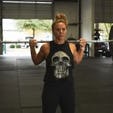Before you begin reading this, let’s get one thing straight: This is NOT your average New Year’s weight-loss workout program. We’re not interested in simply getting you abs and leaving it at that. Onnit is about Total Human Optimization—not training hard just to “tone up” a bit, only to fall off the wagon in six weeks or so (as you know you’ve done in the past).
Conventional physique programs that focus solely on building your muscles and “blasting your abs” only take you so far. Sooner or later your back hurts, your knees ache, you plateau on your exercises, and you wonder what all your hard work is for.
And then what happens? You quit. Time passes, you feel guilty, and you tell yourself you’ll start again in the New Year and give it all you have.
Well, it’s 2021, and it’s high time you stopped making the same mistake.
You CAN have abs, and athleticism, and greater overall health and fitness—without spending considerably more time at the gym—by taking an optimized approach.
Our approach.
Take on our 12-Week Fat Loss Workout Plan, and you’ll not only get in the best shape of your life but know how to keep that shape for the rest of your life.
Who Is This Fat Loss Workout Plan For?
The former athlete looking to get back into fitness, or men and women who have been working diligently for months (or years) but are disappointed with their results. These workouts consist primarily of body-weight exercises, but don’t read that as “easy.” Even an experienced and especially strong lifter will be humbled by them.
What This Fat Loss Workout Plan Will Do For You
You know the conventional approach to getting ripped all too well. Hit one or two body parts at a time, do three sets of 10 reps, isolate the muscles, blah blah blah.
We don’t mean to knock those methods and they certainly have their place, but we feel they present a very one-dimensional view of training, and they limit the potential of what your body can do and even how it can look.
Have you noticed how guys who blast their chests tend to end up with bad posture? How lots of bench pressing hurts your shoulders and crunches make your lower back sore? And it’s probably occurred to you that spending a whole day training your arms means you’ll need to spend another on your back, another on your legs, another on your deltoids… It gets awfully time-consuming, and what good is having a great body if you never have time to do anything else with it?
We say: scrap all that. Start training your body like the integrated system that it is rather than a disjointed collection of parts, and you’ll see better, faster results without side effects.
1. Improved Mobility
First, you need to work to offset the muscle imbalances and limited range of motion you’re no doubt suffering from (perhaps without even realizing it) due to living in the modern world. Only then will you be able to get the best results—from our program or any.
Onnit’s workouts don’t begin with the “first exercise.” The days of doing a few shoulder circles, cracking your knuckles, and loading up the barbell right away in your workout are over. Today, smart coaches know the value of doing a thorough joint mobility warmup first. Each session, we ask that you take five minutes to do a series of mobility drills including neck glides, Egyptians, and lateral hip rooting (shown below). It’s designed to help correct the problems that result from sitting in front of a computer screen, driving in a car, and other activities that tighten the hips and weaken the upper back and core.
This warmup will prepare you to perform the exercises in the main workout more efficiently. It will improve your ranges of motion, and help to prevent injury when you start loading up heavy weights and blasting through circuits—don’t skip it.
2. Strength, Muscle, and Fat Loss
Second, we want you to work the whole body each session, which burns more calories and activates more muscle than body-part splits (much of it in your core). This will automatically have you training each muscle group more frequently. The more often you can train a muscle the faster it will grow, provided you can recover from the previous session. Short, intense, frequent workouts allow you to train hard, recover well, and make gains fast.
The workouts feature a strength superset, which serves as your “meat and potatoes” training—the work that will give you the majority of your results by challenging your muscles with heavy loads that tax your whole body. It’s worth noting that we’ve built some mobility in here as well: we opted for the Romanian deadlift because it’s safer for the lower back than the conventional version, and teaches you to hinge at the hips properly—a fundamental movement skill. This is paired with the dumbbell pullover, which opens up the lats while sparing the elbows, which are often irritated by chinup exercises.
In Workout B, you’ll focus on hanging from a bar in the bottom of a pullup position. Simply holding on and letting your own body weight stretch you is enough grip and core training to qualify as serious strength work, and you’ll see what it does for your ability to do full range pullups down the road.
After the strength superset, you’ll hit a conditioning circuit, in which you’ll perform a series of body-weight exercises that will burn calories and force you to stabilize your body in ways that you can’t while lifting weights. You’ll do as many rounds as you can in 20 minutes one week and Tabata intervals the next. It puts conventional cardio to shame.
3. Better Gains Long-Term
Lastly, you’ll use a decompression circuit (“cool down”) to end each session. This consists of static and dynamic stretches (downward dog, hip flexor stretch) that pull the tension out of your muscles to promote recovery and further improve mobility. As with the warmup, it only takes five minutes, and will help to re-acclimate your body to life outside the gym, and keep you healthy and fit to train for as long as you choose to.
Directions
The program goes for 12 weeks. The workouts for Part 1—Weeks 1–4—appear here (come back in February for Part 2). While the exercises for the first four weeks remain the same, the way in which you perform them will change slightly on a weekly basis. See the “notes” on each week at the bottom of the page.
Perform each workout (Workout A and B) twice per week. An ideal schedule would be to do A on Monday, B on Tuesday, rest Wednesday, do A again Thursday and B Friday. Perform some kind of light recreational activity (walking, biking, swimming, sports, etc.) the remaining days of the week. Repeat the cycle for four weeks.
Begin each workout with the prescribed mobility warmup, and then do the strength superset, conditioning circuit, and decompression.
Each workout should take 45 minutes or less.
For a nutrition plan to accompany the workouts, CLICK HERE.
Fat Loss Workout A
Mobility Warmup
Perform 5 reps of each exercise (on each side, where appropriate) in sequence. Repeat the series for 3 total rounds.
A. Forward/Backward Neck Glide
Stand tall with soft knees and tuck your tailbone slightly so your hips are level with the floor. Think “proud chest,” drawing your shoulder blades back and down. Brace your core and place your hands on your belly to draw awareness to any movement in your torso during the drill (there shouldn’t be any), and slowly extend your neck straight forward. Avoid tilting your head up or down—move it forward as if it were sliding on a straight path. Go as far forward as you can and then retract your head straight back until you feel you’re making a double chin.
B. Double Backward Shoulder Roll
From the same tall standing position described above, allow your arms to hang at your sides and begin rolling your shoulders backward. Make big circles, moving only at the shoulders, drawing them back, down, forward, and up again. Move your shoulders as far as you can in each direction.
C. Egyptian
Raise your arms out 90 degrees, actively reaching them apart as far as you can. Rotate purely at the right shoulder, twisting your arm so your palm faces behind you. Allow your head and torso to rotate to the left as you twist. Unwind your right arm and repeat on the opposite side.
D. Lateral Hip Root
Stand with feet between hip and shoulder-width apart and tilt your pelvis backward. Keeping a “proud chest,” drive your hips back to one side, allowing your knees to bend as needed. Bend as far as you can, reaching your arms out straight for balance. Squeeze your glutes and tuck your pelvis back under as you come back to standing and repeat on the other side.
E. Hacky Sack
Bend one knee 90 degrees and raise that leg up so your thigh is parallel to the floor. Keep your balance and rotate your lower leg in toward the midline of your body as far as you can. Reverse the motion and rotate the leg outward as far as possible.
Strength Superset
Complete one set of 1A and then 1B before resting.
1A. Romanian Deadlift
Sets: 4
Reps: 8
Rest: 0 sec.
Place a loaded barbell on a power rack or mats so that it’s at about mid-thigh level. Grasp the bar with a shoulder-width grip and pull the bar out of the rack so it hangs at arm’s length in front of you. Step back a few feet to clear the rack and stand with feet between hip and shoulder width apart.
Imagine screwing your feet into the floor—twist them out and apart—but not to the point where they actually move. Just activate the muscles on the sides of your hips and feel the tension you’ve created in your lower body. Take a deep breath into your belly and draw your shoulder blades back and down (think of Superman pulling his jacket open to reveal the “S” on his chest). Tilt your hips back.
Begin lowering your torso toward the floor, pushing your hips back as far as you can until you feel a stretch in your hamstrings. Allow your knees to bend as needed. You should feel your weight on your heels.
Keep your spine long from your head to your pelvis. As you bend, keep the bar pulled into your legs the entire time, firing the muscles in your back and keeping a “proud chest” position.
When you’ve gone as far as you can safely, squeeze your glutes to come back up to standing.
1B. Dumbbell Pullover
Sets: 4
Reps: 10
Rest: 120 sec.
Hold a dumbbell by one of its bells with both hands and lie back on a bench, suspending the weight over your chest. Take a deep breath and begin lowering the weight behind your head while keeping your elbows straight.
When you feel a stretch in your lats, pull the weight back up to the starting position using your back muscles.
Conditioning Circuit
Perform the following exercises back to back for 20 minutes. Do not rest in between exercises; work at your own pace. Complete as many rounds (exercises 1A–1D) as possible without stopping and record the number you complete. Try to beat this number in Week 3.
1A. Body-weight Squat
Reps: 20
Stand with your feet between hip and shoulder-width apart and toes turned out slightly. Look straight ahead, take a deep breath, and screw your feet into the floor as you did in the Romanian deadlift.
Drop down as if sitting in a low chair, spreading your knees apart as you descend. Go as low as you feel comfortable while keeping a long spine from your head to your pelvis—your head, back, and hips should form a straight line and your torso should be very vertical. Your knees should line up with your big toes. Drive through the middle of your feet to stand back up.
1B. Pushup
Reps: 10
Place your hands on the floor at shoulder-width apart and extend your legs behind you in a straight line. Your feet should be about hip-width apart. Breathe into your belly and brace your core. Pull your shoulder blades down and together.
Think about twisting your hands into the floor to create tension in your shoulders. Begin lowering your body toward the floor by pulling yourself down with your upper back. Stop when your chest is about an inch above the floor and press back up, continuing to push until your shoulder blades are spread wide apart.
1C. Bicycle Crunch
Reps: 10 (each side)
Lie on your back on the floor and clasp your hands behind your head. Extend your legs in front of you. Crunch your torso off the floor and twist to your left while simultaneously raising your left knee to your chest until your knee and elbow meet. Lower your torso and leg and repeat on the opposite side. You’ll look like you’re pedaling a bicycle. Each twist is one rep.
1D. Hip-Opening Mountain Climber
Reps: 10 (each side)
Get into pushup position and draw your right knee up to the outside of your elbow, pulling the leg inward while driving the arm out so they touch each other firmly. Drive it back and bring the other knee up. Alternate in a steady rhythm (each knee drive is one rep). Keep your core engaged and resist any rotation at the shoulders or hips. Fight to keep your “proud chest” position—try not to let your upper back round forward excessively.
Decompression
Perform each exercise for 60 seconds (30 seconds per side where appropriate).
A. Standing Forward Fold
From the tall, “proud chest” position, bend your hips back and reach behind your ankles. Pull your legs toward you with your arms while simultaneously trying to extend your hips. Keep the tension and feel your lower back open up.
B. Kneeling Hip Flexor Stretch
Kneel on the floor in a lunge position and stack your head and spine directly over your hips. Allow your front knee to drive forward but maintain your upper-body position. You should feel the stretch in the front of your trailing leg. As your hip opens, allow your knee to drift further forward and your hips to stretch more deeply.
C. Kneeling Inverted Pushup Hold
Get on all fours and rest the backs of your hands on the floor directly underneath your shoulders. Keep a “proud chest” position with your spine and hips aligned as you straighten your elbows to feel a stretch on your wrist extensors (in the forearm). Turn your biceps to face forward and hold the position.
D. Downward Facing Dog
Get into a bear crawl position with hands on the floor at shoulder-width apart. Push your feet and hands into the floor to raise your hips into the air. Allow your knees to bend as neeed to keep your head, spine, and hips aligned. Hold the position while actively driving your hands into the floor.
E. Floor Scorpion
Lie on your chest on the floor and spread your arms out 90 degrees. Bend your left leg and drive it up off the floor and over behind your right arm. Plant it flat on the floor and drive it actively into the floor so you feel a stretch in your hips. Allow your shoulder to come up as you turn but try to drive it back down.
Note that the way in which this workout is done changes slightly week to week. Above is what you should do for Week 1. See the “notes” on the bottom of the page for instructions on Weeks 2–4.
Fat Loss Workout B
Mobility Warmup
Repeat the warmup from Workout A.
Strength Superset
Complete one set of 1A and then 1B before resting.
1A. One-Arm Dumbbell Row
Sets: 4
Reps: 8 (each side)
Rest: 0 sec.
Hold a dumbbell in one hand and rest the opposite hand and knee on a bench. Think “proud chest,” drawing your shoulder blades down and together, and row the weight to your side until your upper arm is in line with your torso. Complete your reps and repeat on the opposite side.
1B. Pull-up Bar Hang
Sets: 4
Reps: Hold as long as possible
Rest: 120 sec.
Grasp a pullup bar with hands outside shoulder width and palms facing away from you. Draw your shoulder blades down and try to pull them together. Pull your ribs down. Think about keeping your head, spine and hips aligned and making your spine as long as possible. Hang from the bar as long as you can.
Conditioning Circuit
Perform the following exercises back to back for 20 minutes. Do not rest in between exercises; work at your own pace. Complete as many rounds (exercises 1A–1D) as possible without stopping and record the number you complete. Try to beat this number in Week 3.
1A. Split Squat
Reps: 10 (each side)
Lunge forward with one foot so your feet are staggered. Keeping your torso upright, lower your body until your rear knee nearly touches the floor. Come back up. Complete all your reps on one leg and then switch legs and repeat.
1B. Twist And Sit
Reps: 10 (each side)
Get into a bear crawl position—on the balls of your feet with your knees under your hips and hands under your shoulders. Rotate your body to the right, pivoting on your right foot and turning until your left hip can touch the floor—hold for a moment and feel the stretch. Reverse the motion and repeat on the opposite side. Keep your shoulders square to the floor the whole time.
1C. V-Up
Reps: 20
Lie on your back on the floor and raise both hands behind your head. Extend your legs. Take a deep breath and brace your abs. Sit up all the way, raising your legs simultaneously. Your body should form a V shape at the top.
1D. Alternating Tripod Extension
Reps: 5 (each side)
Sit on the floor with hips and knees bent 90 degrees and feet flat. Twist your torso to place your left elbow inside your right thigh and rest your right arm on the floor behind you. Think “proud chest” and take a deep breath. Brace your core.
Drive through your heels and bridge your hips up until your body forms a straight line from your head to your knees. As you rise, reach your left arm to the ceiling. Reverse the motion and repeat on the other side. Both sides equals one rep.
Decompression
Repeat the cool down from Workout A.
Note that the way in which this workout is done changes slightly week to week. Above is what you should do for Week 1. See the “notes” below for instructions on Weeks 2–4.
Week 1 Notes – Set Your Pace:
Don’t compete with yourself too hard this week. Your main goal is to determine what loads to use and make sure your form is precise. If you have to reduce the weight you’re using between sets, so be it. Keep a log, recording the weights you use and how the workouts feel. In a few weeks, you’ll be able to look back and see how far you’ve come.
On the conditioning circuit, try to find a comfortable pace that allows you to keep moving for the full 20 minutes. If you need to take breaks because your muscles are fatigued, take note of which body parts are fatiguing faster than others. If it’s your lungs that need the break, slow down and focus on breathing between each rep of every exercise. You’re welcome to perform your reps with a bit more time in between them. Each rep should be done with crisp technique. You will be able to pick up the pace each week.
Week 2 Notes – Compress The Workload:
Now that you’ve found the appropriate weights to use for your strength exercises, aim to get the same amount of work done with them in less time.
The rest period at the end of the superset now drops to 90 seconds.
This can have a significant effect on how you feel in the last few sets, so make sure not to increase the loads you’re using until you’re sure you can complete all the prescribed reps for them while respecting the rest time.
The format of the conditioning circuit changes too. You’ll now perform each exercise not for reps but for time. You’ll work for 20 seconds and then take 10 seconds off (you may know this as the “Tabata Protocol”) and repeat for 8 total sets before moving on to the next exercise. Note that, technically, this is not a circuit anymore but straight sets. For example, you’ll do squats for 20 seconds, then rest 10, and repeat for 8 sets. Then you’ll go on to do pushups, bicycle crunches, and mountain climbers in the same fashion. Rest one minute between exercises.
This change-up will increase the endurance demands on your muscles dramatically, so be sure to do your reps at a conservative pace. Make note of the reps you can do each set for each exercise. Afterward, add the lowest score of all your sets for each movement. This is the number you want to beat the next time.
Week 3 Notes – Turn Up The Volume:
This week returns to the format used in Week 1.
The strength supersets will continue to be done with 90 seconds rest but the number of sets will increase. Do 5 sets each for the pair.
One set may not sound like much but it represents a 25% increase in workload. It should feel substantially different than last week even if you use the same weights.
The conditioning circuit returns to reps instead of work and rest intervals, and you’ll complete as many rounds as possible in 20 minutes again. Try to beat the number you recorded in Week 1.
Week 4 Notes – Test Yourself:
Reduce the rest for the strength superset to 60 sec. Perform the conditioning work as a Tabata again and try to increase your score by one rep on every exercise.

)





